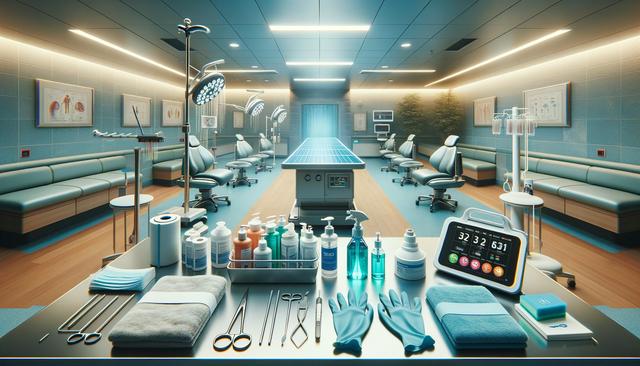The Importance of Cleanliness in Medical Facilities
In healthcare environments, the standard of cleanliness directly impacts patient safety and public health outcomes. Medical facilities, from general clinics to specialized treatment centers, must adhere to strict cleaning and disinfection procedures to minimize the spread of infections and maintain a sterile environment. Given the constant exposure to pathogens, these environments require more than just surface-level cleaning—they demand comprehensive sanitization performed by trained professionals. Certified cleaning teams for healthcare facilities are equipped with the skills and knowledge to meet these stringent requirements, ensuring that every area is properly decontaminated.
Contaminants in medical settings can include bloodborne pathogens, bacteria, viruses, and other biohazardous materials. Effective cleaning involves understanding the risks associated with each zone—such as operating rooms, patient wards, and laboratories—and using the correct methods and agents for each. A targeted approach reduces the risk of healthcare-associated infections (HAIs), which are a serious concern in medical environments. Maintaining high standards of hygiene is not only a regulatory obligation but also an ethical responsibility to protect patients, staff, and visitors.
Protocols and Standards for Disinfection
Disinfection in healthcare settings follows protocols defined by health authorities and infection control guidelines. These protocols dictate the types of disinfectants used, the frequency of cleaning, and the methods of application. Certified cleaning teams for healthcare facilities are trained to follow these protocols meticulously, ensuring compliance with local and national health regulations.
Some of the key practices in medical disinfection include:
- Using EPA-approved disinfectants effective against a broad range of pathogens
- Applying dwell times as recommended by product manufacturers
- Cleaning from low-risk to high-risk areas to prevent cross-contamination
- Disposing of medical waste in line with hazardous waste regulations
These practices are implemented alongside routine cleaning schedules and emergency disinfection procedures, especially during outbreaks of infectious diseases. The coordination between facility management and cleaning teams is crucial to ensure that no area is overlooked and that all cleaning activities are logged and tracked for accountability.
Specialized Equipment and Materials
Cleaning medical facilities requires specialized equipment and materials that go beyond what is used in standard commercial cleaning. Certified cleaning teams for healthcare facilities utilize tools designed to reduce the risk of cross-contamination and increase cleaning efficiency. These include microfiber cloths, no-touch cleaning systems, and HEPA-filtered vacuum equipment.
Key tools and supplies often used include:
- Color-coded cleaning systems to prevent cross-use between different areas
- Electrostatic sprayers for even and thorough disinfectant application
- Personal protective equipment (PPE) for cleaning personnel
- Autoclaves and other sterilization devices for reusable tools
Using the right equipment ensures that disinfection efforts are comprehensive and consistent. Moreover, regular maintenance and calibration of these tools are necessary to preserve their effectiveness and meet regulatory standards. Without these specialized resources, it would be challenging to maintain the rigorous hygiene levels expected in healthcare settings.
The Role of Trained and Certified Cleaning Personnel
The success of any cleaning and disinfection program in a medical facility depends significantly on the competency of the cleaning staff. Certified cleaning teams for healthcare facilities receive specialized training in infection control, hazardous material handling, and the proper use of disinfectants and equipment. This training ensures they are prepared to handle the unique challenges present in a medical setting.
Certification typically covers areas such as:
- Understanding of pathogen transmission and prevention
- Safe handling and disposal of biohazardous waste
- Knowledge of cleaning protocols for different medical zones
- Emergency response procedures for contamination events
Having a team of certified professionals also supports facility accreditation and can improve patient trust. Many healthcare providers view a well-trained cleaning team as an extension of their infection control strategy. It demonstrates a commitment to health and safety at every level of facility operations.
Monitoring, Documentation, and Continuous Improvement
Effective cleaning in healthcare environments is not a one-time activity—it involves ongoing monitoring and continuous improvement. Certified cleaning teams for healthcare facilities play a vital role in documenting cleaning activities, reporting issues, and adapting procedures based on feedback and new health guidelines. Facility managers often use digital tracking systems to log cleaning schedules, verify task completion, and audit performance.
Strategies for quality assurance include:
- Routine inspections and microbial surface testing
- Regular training updates and performance reviews
- Feedback loops between clinical staff and cleaning teams
- Implementation of new technologies based on industry innovations
Continuous improvement fosters a culture of safety and accountability. By investing in monitoring tools and open communication channels, healthcare facilities can ensure that their cleaning practices evolve alongside emerging threats and technological advancements. This proactive approach helps minimize risks and supports the overall mission of providing high-quality patient care.
Conclusion: Prioritizing Hygiene for Health and Safety
Maintaining a clean and disinfected medical environment is essential for protecting patients, healthcare workers, and visitors. Certified cleaning teams for healthcare facilities bring a level of expertise and professionalism that is crucial in achieving the high standards required in these sensitive environments. By following strict protocols, using specialized equipment, and embracing continuous improvement, these teams help ensure that healthcare settings remain safe, compliant, and trustworthy. Facility managers and healthcare administrators should prioritize partnering with certified professionals to uphold hygiene standards and support comprehensive infection prevention strategies.




Leave a Reply